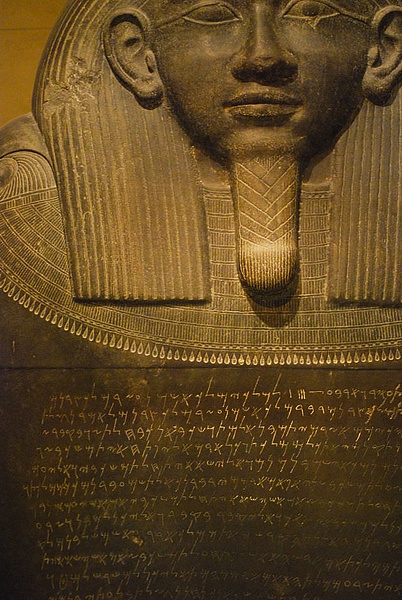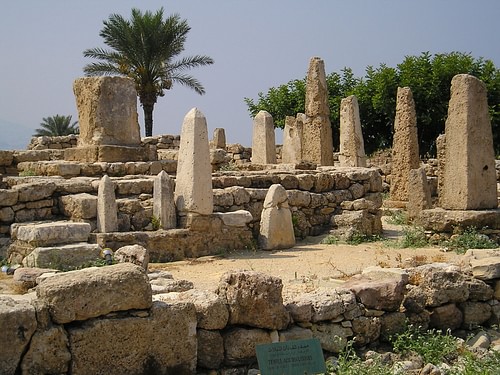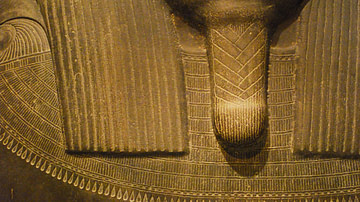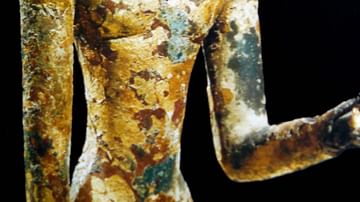
Eshmunazar II (also Eshmunazor II) was a king of the Phoenician city of Sidon during the Persian period. He was the third king of his family, after his his father and his grand-father. He was the son of Tabnit and Amashtart, and the grand-son of Eshmunazar I, the founder of the dynasty. He only lived 14 years and during his reign, he ruled the kingdom with his mother. Because he had no children, he was succeeded by his cousin Bodashtart. There is no confirmation about the exact dates of his reign, but the most possible date is around 525 BCE. The Persian king of this time was Cambyses, who waged war against Egypt with the help of Phoenician ships.
After Cambyses' victory, Egypt became part of the Persian empire and relations between the Persian king and the king of Sidon were good. The Frensh archaeologist Ernest Renan found Eshmunazor II's coffin in the south-east necropolis of Sidon (Maghart Tabloun necropolis) in 1855. The coffin was made from basalt that had been imported from Egypt (in fact it was taken off a tomb in the Egyptian capital Memphis, during the Persian occupation and shipped to Sidon). The Egyptian text was erased and a Phoenician text was written, which reads:
In the month of Bul, in the fourteenth year of the royalty of King ESHMUNAZAR, King of the Sidonians, son of King TABNIT, King of the Sidonians, King ESHMUNAZAR, King of the Sidonians, said as follows: I am carried away, the time of my non-existence has come, my spirit has disappeared, like the day, from whence I am silent, since which I became mute.
And I am lying in this coffin, and in this tomb, in the place which I have built. O thou (reader) remember this: "May no royal race and no man open my funeral couch, and may they not seek after treasures, for no one has hidden treasures here, nor move the coffin out of my funeral couch, nor molest me in this funeral bed, by puttiiig another tomb over it. Whatever a man may tell thee, do not listen to him: For the punishment (of the violators) shall be : Every royal race and every man, who shall open the covering or this couch, or who shall carry away the coffin where I repose, or who shall molest me in this couch : they shall have no funeral couch with the Rephaïm, nor shall be buried in graves, nor shall there be any son or offspring to succeed to them, and the sacred gods shall inflict extirpation on them.
Thou whoever (thou art who wilt) be King (hereafter), inspire those over whom thou wilt reign, that they may exterminate the members of the royal race (like those men) who will open the covering of this couch, or who will take away this coffin, and (exterminate) also the offspring of this royal race, or of these men of the crowd. There shall be to them no root below, nor fruit above, nor living form under the sun. For graced by the gods, I am carried away, the time of my non-existence has come, my spirit has disappeared, like the day, from whence I am silent, since which I became mute.
For I, ESHUNAZAR, King of the Sidonians, son of King TABNIT, King of the Sidonians (who was), the grandson of King ESMUNAZAR, King of the Sidonians, And my mother AMASTARTE, the Priestess of ASTARTE, our mistress, the Queen, the daughter of King ESMUNAZAR, King of the Sidonians : It is we who have built the temple of the gods, and the temple of ASTAROTH, on the seaside Sidon, and have placed there the image of the ASTAROTH, as we are sanctifiers (of the gods). And it is we who have built the temple of ESHMUN, and the sanctuary of the purpleshells River on the mountaln, and have placed there his image, as we are sanctifiers (of the gods). And it is we who have built the temples of the gods of the Sidonians, in the seaside Sidon, tile temple of BAAL-SIDON and the temple of ASTARTE who bears the name of this BAAL. May in future the Lords of the Kings give us Dora and Japhia, the fertile corn-lands, which are in tile plain of Saron, and may they annex it to the boundary of the land, that it may belong to the Sidonians for ever.
O thou, remember this: May no royal race and no man open my covering, nor deface (the inscriptions of) my covering, nor molest me in this funeral bed, nor carry away the coffin, where I repose. Otherwise, the sacred gods shall inflict extirpation on them and shall exterminate this royal race and this man of the crowd and their offspring for ever.
The inscription is probably one of the most famous Phoenician texts. Today, the coffin is on display in the Louvre Museum (Paris).






